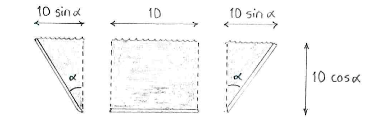Lösung 1.3:5
Aus Online Mathematik Brückenkurs 2
K (Solution 1.3:5 moved to Lösung 1.3:5: Robot: moved page) |
|||
| Zeile 1: | Zeile 1: | ||
| - | + | Der Kanal kann am meisten Wasser enthalten, wenn seine Querschnittsfläche am größten ist. | |
[[Image:1_3_5_1_1.gif|center]] | [[Image:1_3_5_1_1.gif|center]] | ||
| - | + | Indem wir den Querschnitt des Kanals in ein Rechteck und zwei Dreiecke aufteilen, können wir mit ein wenig Trigonometrie die Querschnittsfläche des Kanals berechnen. | |
[[Image:1_3_5_1_2.gif|center]] | [[Image:1_3_5_1_2.gif|center]] | ||
| - | + | Die Fläche ist | |
{{Abgesetzte Formel||<math>\begin{align} | {{Abgesetzte Formel||<math>\begin{align} | ||
| Zeile 14: | Zeile 14: | ||
\end{align}</math>}} | \end{align}</math>}} | ||
| - | + | Begrenzen wir den Winkel sodass er zwischen <math>0</math> und <math>\pi/2</math> liegt, erhalten wir das Problem: | |
| - | :: | + | ::Maximiere <math>A(\alpha) = 100\cos\alpha (1+\sin\alpha)</math> wenn |
<math>0\le \alpha \le {\pi }/{2}\,</math>. | <math>0\le \alpha \le {\pi }/{2}\,</math>. | ||
| - | + | Die Funktion ist überall differenzierbar, und die Fläche ist minimal wenn <math>\alpha=0</math> oder wenn <math>\alpha=\pi/2\,</math>, Und also nimmt die Funktion ihr Maxima für einen stationären Punkt an. | |
| - | + | Die Ableitung ist | |
{{Abgesetzte Formel||<math>\begin{align} | {{Abgesetzte Formel||<math>\begin{align} | ||
| Zeile 28: | Zeile 28: | ||
\end{align}</math>}} | \end{align}</math>}} | ||
| - | + | Für stationäre Punkte ist <math>A'(\alpha)=0</math> und dies ergibt die Gleichung | |
{{Abgesetzte Formel||<math>\sin\alpha + \sin^2\!\alpha - \cos^2\!\alpha = 0</math>}} | {{Abgesetzte Formel||<math>\sin\alpha + \sin^2\!\alpha - \cos^2\!\alpha = 0</math>}} | ||
| - | + | Nachdem wir den Faktor -100 heraus gezogen haben. Wir ersetzen <math>\cos^2\!\alpha</math> mit <math>1-\sin^2\!\alpha</math> und erhalten eine Gleichung mit nur <math>\sin\alpha\,</math>-Termen, | |
{{Abgesetzte Formel||<math>\begin{align} | {{Abgesetzte Formel||<math>\begin{align} | ||
| Zeile 39: | Zeile 39: | ||
\end{align}</math>}} | \end{align}</math>}} | ||
| - | + | Dies ist eine quadratische Gleichung für <math>\sin\alpha</math>, und durch quadratische Ergänzung erhalten wir | |
{{Abgesetzte Formel||<math>\begin{align} | {{Abgesetzte Formel||<math>\begin{align} | ||
| Zeile 46: | Zeile 46: | ||
\end{align}</math>}} | \end{align}</math>}} | ||
| - | + | und wir erhalten weiter <math>\sin\alpha = -\tfrac{1}{4}\pm \tfrac{3}{4}</math>, also <math>\sin \alpha = -1</math> oder <math>\sin \alpha = \tfrac{1}{2}\,</math>. | |
| - | + | Der Fall dass <math>\sin \alpha =-1</math> ist nie erfüllt für <math>0\le \alpha \le \pi/2</math> und <math>\sin \alpha = \tfrac{1}{2}</math> gibt <math>\alpha = \pi/6</math>. Also ist <math>\alpha = \pi/6\,</math> ein stationärer Punkt. | |
| - | + | Wir wissen von der Figur her dass die Fläche lokale Minima in den Punkten <math>\alpha = 0</math> und <math>\alpha = \pi/2</math> hat, und den kritischen Punkt <math>\alpha = \pi/6\,</math>. Daher muss der kritische Punkt ein Maxima sein, aber wir zeigen dies auch mit der zweiten Ableitung, | |
{{Abgesetzte Formel||<math>\begin{align} | {{Abgesetzte Formel||<math>\begin{align} | ||
| Zeile 58: | Zeile 58: | ||
\end{align}</math>}} | \end{align}</math>}} | ||
| - | + | Dieser Ausdruck ist negativ für <math>\alpha = \pi/6</math>, | |
{{Abgesetzte Formel||<math>\begin{align} | {{Abgesetzte Formel||<math>\begin{align} | ||
| Zeile 65: | Zeile 65: | ||
\end{align}</math>}} | \end{align}</math>}} | ||
| - | + | Also ist <math>\alpha = \pi/6\,</math> ein globales Maxima, nachdem es das einzige lokale Maxima ist. | |
Version vom 12:09, 27. Apr. 2009
Der Kanal kann am meisten Wasser enthalten, wenn seine Querschnittsfläche am größten ist.
Indem wir den Querschnitt des Kanals in ein Rechteck und zwei Dreiecke aufteilen, können wir mit ein wenig Trigonometrie die Querschnittsfläche des Kanals berechnen.
Die Fläche ist
| \displaystyle \begin{align}
A(\alpha) &= 10\cdot 10\cos\alpha + 2\cdot\frac{1}{2}\cdot 10\cos\alpha \cdot 10\sin\alpha\\[5pt] &= 100\cos \alpha (1+\sin\alpha)\,\textrm{.} \end{align} |
Begrenzen wir den Winkel sodass er zwischen \displaystyle 0 und \displaystyle \pi/2 liegt, erhalten wir das Problem:
- Maximiere \displaystyle A(\alpha) = 100\cos\alpha (1+\sin\alpha) wenn
\displaystyle 0\le \alpha \le {\pi }/{2}\,.
Die Funktion ist überall differenzierbar, und die Fläche ist minimal wenn \displaystyle \alpha=0 oder wenn \displaystyle \alpha=\pi/2\,, Und also nimmt die Funktion ihr Maxima für einen stationären Punkt an.
Die Ableitung ist
| \displaystyle \begin{align}
A'(\alpha) &= 100\cdot (-\sin\alpha)\cdot (1+\sin\alpha) + 100\cdot\cos\alpha \cdot \cos\alpha\\[5pt] &= -100\sin\alpha - 100\sin^2\!\alpha + 100\cos^2\!\alpha\,\textrm{.} \end{align} |
Für stationäre Punkte ist \displaystyle A'(\alpha)=0 und dies ergibt die Gleichung
| \displaystyle \sin\alpha + \sin^2\!\alpha - \cos^2\!\alpha = 0 |
Nachdem wir den Faktor -100 heraus gezogen haben. Wir ersetzen \displaystyle \cos^2\!\alpha mit \displaystyle 1-\sin^2\!\alpha und erhalten eine Gleichung mit nur \displaystyle \sin\alpha\,-Termen,
| \displaystyle \begin{align}
\sin\alpha + \sin^2\!\alpha - (1-\sin^2\!\alpha) &= 0\\[5pt] 2\sin^2\!\alpha + \sin\alpha - 1 &= 0\,\textrm{.} \end{align} |
Dies ist eine quadratische Gleichung für \displaystyle \sin\alpha, und durch quadratische Ergänzung erhalten wir
| \displaystyle \begin{align}
2\bigl(\sin\alpha + \tfrac{1}{4}\bigr)^{2} - 2\bigl(\tfrac{1}{4}\bigr)^2 - 1 &= 0\\[5pt] \bigl(\sin\alpha + \tfrac{1}{4}\bigr)^2 &= \frac{9}{16} \end{align} |
und wir erhalten weiter \displaystyle \sin\alpha = -\tfrac{1}{4}\pm \tfrac{3}{4}, also \displaystyle \sin \alpha = -1 oder \displaystyle \sin \alpha = \tfrac{1}{2}\,.
Der Fall dass \displaystyle \sin \alpha =-1 ist nie erfüllt für \displaystyle 0\le \alpha \le \pi/2 und \displaystyle \sin \alpha = \tfrac{1}{2} gibt \displaystyle \alpha = \pi/6. Also ist \displaystyle \alpha = \pi/6\, ein stationärer Punkt.
Wir wissen von der Figur her dass die Fläche lokale Minima in den Punkten \displaystyle \alpha = 0 und \displaystyle \alpha = \pi/2 hat, und den kritischen Punkt \displaystyle \alpha = \pi/6\,. Daher muss der kritische Punkt ein Maxima sein, aber wir zeigen dies auch mit der zweiten Ableitung,
| \displaystyle \begin{align}
A''(\alpha) &= -100\cos\alpha - 100\cdot 2\sin\alpha\cdot\cos\alpha + 100\cdot 2\cos\alpha \cdot (-\sin\alpha)\\[5pt] &= -100\cos\alpha (1+4\sin\alpha)\,, \end{align} |
Dieser Ausdruck ist negativ für \displaystyle \alpha = \pi/6,
| \displaystyle \begin{align}
A''(\pi/6) &= -100\cos\frac{\pi}{6}\cdot \Bigl(1+4\sin\frac{\pi}{6}\Bigr)\\[5pt] &= -100\cdot\frac{\sqrt{3}}{2}\cdot \Bigl( 1+4\cdot \frac{1}{2} \Bigr)<0\,\textrm{.} \end{align} |
Also ist \displaystyle \alpha = \pi/6\, ein globales Maxima, nachdem es das einzige lokale Maxima ist.


